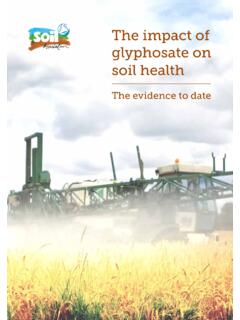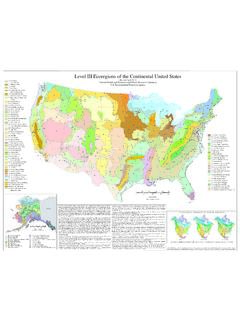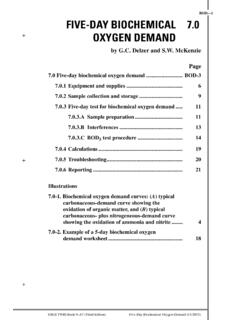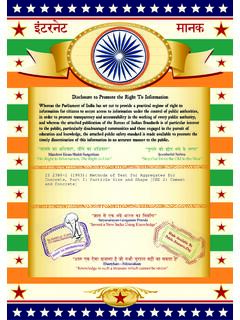Transcription of Soil pH – how to measure and manage it based on an ...
1 Action points for farmers and growers Know the texture and type of soils on your holding Test your soil pH regularly (at least once every four years and ideally once every two years if you are a high value crop grower on a light soil) and interpret the results correctly for your own soil types Choose an appropriate sampling strategy for your own farm and be prepared to spend money on more samples where you find evidence that soil pH could be impacting on crop yield or where you suspect big differences in soil pH within fields Be aware that some organic materials applied to improve soil health ( composts, digestates and some types of paper crumble) have a liming (or neutralising) value.
2 It is easy to test these materials for their liming value so that you can determine the likely effect of using them at different application rates on soil pH Be aware of the differences between different types of liming agents and their relative advantages and disadvantages. As well as bearing in mind price, choose those appropriate for your own soilsFigure 1. Lime spreadingGREATSOILSSoil pH how to measure and manage it based on an understanding of soil textureAudrey Litterick, Earthcare Technical BackgroundMaintaining optimum soil pH values in all parts of the field is essential in order to maintain soil quality and health, crop quality and yield.
3 This guidance document explains why soil pH is important and outlines the impact of soil type and texture on pH. It describes how and when to test soils for pH, how to calculate the amount of lime or other neutralising materials required, which liming product(s) to use and how and when to apply pH is a measure of the relative acidity or alkalinity of a soil. While the scale goes from 0 to 14 (with a neutral pH represented by ) most agricultural soils have pH values of between and The pH scale is logarithmic; that is a pH of 5 is ten times more acidic than a pH of 6. The natural pH of a soil is determined by its chemical composition, but most agricultural soils with natural pH values of less than 7 will gradually acidify over time and regular applications of lime will be needed to maintain soil pH at target (Figure1).
4 Soil pH has a profound effect on nutrient availability to crops, with most essential plant nutrients being most available to most crop plant species within the pH range of to Crop quality and yield can be severely affected where soil pH is not maintained close to target for the soil and crops in question and total crop failure is possible in vegetable crops where trace element deficiency has resulted from inappropriate soil pH. Soil pH also affects uptake of potentially toxic elements (PTEs), with PTEs such as cadmium made more available for crop uptake at lower pH values. Soil pH also affects the numbers, diversity and functions of beneficial and pathogenic micro-organisms as well as the larger organisms including both soil-dwelling pest species and beneficial macrofauna species.
5 For example, the soil-borne pathogen Plasmodiophora brassicae, which causes clubroot in vegetable brassicas and oilseed rape, prefers more acidic soils, and liming to raise the soil pH is a management option for clubroot control. Earthworms are most abundant and active in soils with pH values between and 7 and most species cannot function well in soils with pH values lower than to correct soil acidity can cause substantial yield losses and a decline in soil quality and health. Over-use of lime (or certain organic materials which have neutralising values) can create problems with trace element availability.
6 A survey by the Professional Agricultural Analysis Group in 2015/16 found that soil pH was less than in 17% of arable soils tested and less than in 19% of grassland soils tested. Understanding soil types and soil textureYou can more effectively manage the pH of your soils if you understand their key properties including, in particular, the depth, texture and organic matter content of the main horizons (or layers). Texture can be defined as the relative proportions of sand, silt and clay in a soil. The depth, texture and organic matter content affect the target pH value which you should set for each field and will help determine how much lime (or liming agent) to add and how soils have been comprehensively surveyed, tested, classified and studied over the past 75 years, but it is only very recently that practical information on soil types has become widely available digitally and online through the development of web- based England and Wales, the LandIS Soils Portal, developed by Cranfield Soil and AgriFood Institute (CSAI)
7 , allows users to access a wide variety of information on soils. Within the portal, the Soilscapes website ( ) conveys a summary of the broad regional differences in the soil landscapes of England and Wales. It has been tailored to provide extensive, understandable and useful interpreted soil data for the non-soil specialist. It is not intended as a means for supporting detailed studies of farm soils or to support commercial activities. For such applications, a parallel service, Soils Site Reporter ( ) provides comprehensive reporting for specific locations. In Scotland, the National Soils Database for Scotland is held by the James Hutton Institute and the SIFSS (Soil Information for Scottish Soils) website has been created with the aim of allowing users to access information on soils throughout Scotland ( ).
8 SIFSS is also available from the same web page as a free iphone app for you to find out about the soil types in your area, discover the differences between cultivated and uncultivated soils and also to examine a range of key indicators of soil quality . Also available for soils throughout the UK is the British Geological Society (BGS) mySOIL smartphone app ( ). This app seeks to promote the distribution of freely available data through smartphone and tablet technologies. mySoil lets you take a soil properties map of Britain with you wherever you go, helping you learn about the soil beneath your feet.
9 At the national level, soils are often mapped by Major Soil Group or sub-group, but at the farm level, soil series is the mapping unit and there are typically between two and four soil series on any one farm. Being able to identify the soil types on your farm and linking them to knowledge of the soil characteristics is an important first step in helping you to manage your soils more sustainably and profitably. Recent improvements in the availability of soils information online means that farmers can learn about their own soils easily and with very little Management Guide (RB209) and Scottish Technical Notes A simplified approach to soil types is taken in the Nutrient Management Guide (RB209) and Technical Notes, although the definitions used differ between England/Wales and Scotland.
10 In England and Wales, mineral soils Figure 2. Assessment of Soil Texture, courtesy of SRUC(< 10% organic matter) are grouped into light sand; shallow; medium; deep clayey and deep silty soils. Organic soils are defined as containing between 10 and 20% organic matter and peaty soils more than 20% organic Scotland, mineral soils (< 15% organic matter) are grouped into shallow; sands; sandy loams and other mineral soils . Other mineral soil textures include sandy silt loam, silt loam and clay soils (with > 15% clay content). Organic soils are grouped into humose (between 15 and 35% organic matter) and peaty soils (> 35% organic matter).









